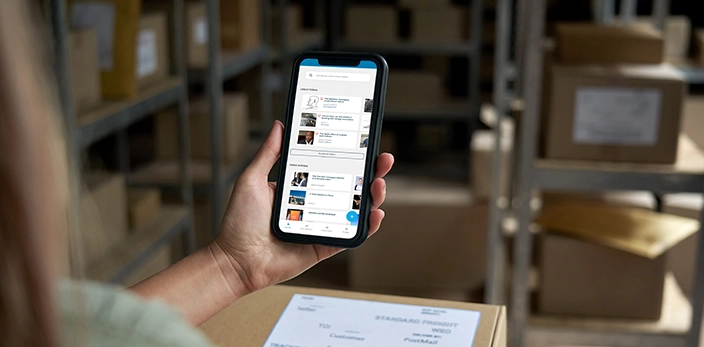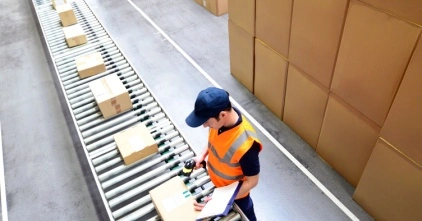Frontline employees want training that complements—not competes with—the way they work. Here’s how you can design a personalized learning program with their needs in mind.

While the business world has become more amenable to remote work, a large number of workers still need to be physically present to do their jobs. In fact, they represent 80 percent of the global workforce.
Known as “deskless” workers, they are the unsung heroes of industries that support the global economy. They can be found in many industries, including retail, hospitality, healthcare, transportation, banking, customer service, and many others.
Their work cannot be completed remotely, which makes them highly valuable to society.
However, they are also one of the most challenging groups for HR to support. Their reality is different from their deskbound counterparts. They aren’t just disengaged, but also overlooked.
Today, frontline employees need to feel more supported and empowered in their roles. But only if their leaders take charge.
Training is Failing the Frontline
The “great frontline resignation” is afoot. Despite their significance, the frontlines are still seeing high turnover rates caused by a lack of career advancement opportunities.
When companies struggle to keep deskless workers, productivity, efficiency, and morale all suffer. So will your customers.
Imagine people at their desks taking a structured training session. Easy to put in place, right? All you need to do is provide webinars, videos, or course content, and you’re all set. Corporate training is usually designed this way.
Now think of the deskless workforce. Shifting schedules, limited access to technology, and dispersed work locations make traditional training ineffective. And companies can’t afford to have these employees sit in a classroom for hours because it takes them away from their job.
To bridge the gap between the unique challenges faced by deskless workers and the need for training, a shift toward tailored learning approaches is necessary.

Elevating the Deskless Learning Experience
When deskless employees receive training that meets them where they are, they’ll be able to feel more engaged, productive, and empowered.
Here are five ways you can give personalized training to frontline workers and enable them to do their jobs with pride:
1. Democratize access
If you want your employees to be agile, so should your training.
While desk-based workers have constant access to technology for easier collaboration and communication, frontline employees don’t. Only 23% have the right technology they need to do their jobs, and 86% want better tech.
To achieve true learning in the flow of work, removing access barriers is crucial.
Training should be accessible, intuitive, and simplified. That said, create an experience that only takes a few clicks. You can do this by going mobile-first, integrating training into your existing Learning Experience Platform (LXP), and enabling Single Sign-On (SSO).
By removing the need to log in every time, you allow learners to easily access their training materials on the company’s intranet. You are also relieving them with the technostress that comes with digital learning.
Like goFLUENT, seamless access to language training is possible through integrations. No passwords or additional downloads required. Learners are instantly registered upon their first sign-on, enabling them to go straight to their learning platform.

2. Provide bite-sized, relevant content
Now you have placed training at their fingertips, it’s time to provide impactful content.
Insights from a Coveo study reveal that deskless employees waste an average of 2.5 hours a day searching for information. And when they do, 41% of the information is irrelevant to their job role. To prevent this disruption, resources should be short yet highly applicable.
Provide training paths based on their role, industry, and needed business skills. Allow them to build professional skills they can use in the workplace such as global communication, team collaboration, and managing customer relationships.
Better yet, allow them to explore content that fits their needs and interests.
Frontline employees frequently encounter challenges while on the job. Hence, they need a platform that enables quick access to relevant content, aiding them to handle these issues.
goFLUENT’s AI-powered eLearning platform, Corporate Language Academy makes this an easy feat. Looking into a learner’s profile, relevant learning activities will appear right on their dashboard. Searching for specific topics is also just as effortless.
The key is simple: ensure that learning content resonates with deskless employees, allowing them to maximize their time effectively.
3. Make learning social
Successful upskilling requires doing. People need a chance to practice and master skills in spaces they feel safe to share perspectives, ask questions, and receive feedback. Not only does this make training more enjoyable, but also meaningful.
The Josh Bersin Company shares that deskless workers are most driven by the need to connect with others, and therefore they need that connection to thrive. Hence, including a human element in training is essential.
As learning leaders, creating opportunities for more two-way conversations helps the deskless worker feel more connected and have a sense of community.
Encourage interactions through one-on-one training sessions or group discussions. You can also add modern collaboration tools to help visualize ideas and collaborate on documents.
With goFLUENT, professional language trainers facilitate social learning in virtual group classes. They also provide personalized feedback, ensuring better language learning retention and progress.
Thanks to them, learners can improve their speaking skills in professional interactions, and have their individual needs addressed immediately.

Shaping Success at the Frontlines
It’s time to move deskless training experience up the priority list by personalizing their learning with the right technology, content, and human interaction.
As the demands of the deskless workforce continue to evolve, it is essential for organizations to invest in HR solutions that can effectively cater to their employees where they are and whatever their needs may be.
Whether your goal is to enhance customer service, increase sales, or maintain a positive and productive team, dedicating your resources to frontline training is a step in the right direction.
We owe it to the people who power our lives.



